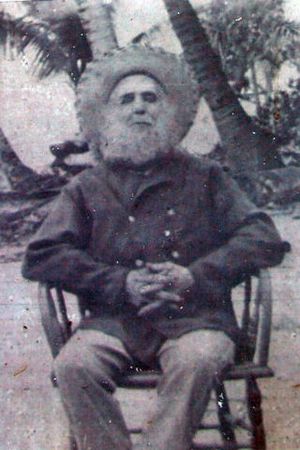William Marsters facts for kids
Quick facts for kids
William Marsters
|
|
|---|---|

William Marsters on Palmerston Atoll
|
|
| Born |
Richard William Masters
6 November 1831 Walcote, Leicestershire
|
| Died | 22 May 1899 (aged 67) Palmerston Island, Cook Islands
|
| Occupation | Sailor, cooper, merchant |
| Known for | English adventurer who settled on Palmerston Island in the Pacific |
William Marsters (born Richard Masters) was an Englishman who settled on Palmerston Island in the Cook Islands. He arrived there on July 8, 1863. He came with his Polynesian wife and two other Polynesian women.
Today, some of his family still live on Palmerston Island. Many more of his descendants live in Rarotonga or other parts of the Cook Islands. Others live in New Zealand and Australia. William Marsters was born on November 6, 1831, and passed away on May 22, 1899.
Contents
William Marsters' Life Story
William Marsters was born Richard Masters in 1831 in Leicestershire, England. He traveled to the Pacific Ocean around 1856. He first settled on Penrhyn, which is the most northern of the Cook Islands.
He married the daughter of a local chief on Penrhyn. In 1862, they moved to Manuae. Then, on July 8, 1863, they moved to Palmerston Island. His wife's cousin came with them, and William later had children with her.
William's job was to make copra (dried coconut meat) and collect bêche-de-mer (sea cucumbers). He was doing this for a trader from Tahiti named Brander. However, Brander never came back for the goods.
William Marsters decided to make Palmerston Island his permanent home. He also started a family with a third woman. The people living on Palmerston today are descendants of these three Penrhyn women. William Marsters died on May 22, 1899, when he was 67 years old. He had 23 children and 134 grandchildren.
Who Owns Palmerston Island?
In 1887, a man named George Darsie tried to stop William Marsters from leasing the island. Palmerston Island officially became part of the United Kingdom on May 23, 1891.
In 1892, the British Government gave William a 21-year lease for the island. This lease was later extended until 1954. In 1954, the Marsters family was given full ownership of Palmerston Atoll. This happened because of a change to the Cook Islands Act by the New Zealand Government.
How Leaders Are Chosen
Two years after William Marsters died, people disagreed about who should lead the island next. In 1901, Colonel Walter Edward Gudgeon was the British representative in Rarotonga. He chose William's oldest son, Joel, to be the agent for the British and the Magistrate for the island.
In 1992, the Palmerston Act was passed. Today, Palmerston Island is governed by this Act. It also follows the Outer Island Act.
The Island Council Today
Before William Marsters passed away, he organized the island's land. He made sure that each of his three families and their descendants had a share of the main island. They also got a share of the other small islands in the atoll. This way of sharing the land is still used today.
Today, Palmerston Island has its own council. This council acts as the local government. It has six members. The head of each of the three main families (Matavia, Akakaingaro, and Te Pou) is on the council. Each family also chooses one more member to join. These appointments happen every four years. The Mayor of the Island is chosen from one of the three family heads. They take turns being mayor.
Each of the three families on Palmerston has its own version of the island's history. They also have their own stories about William Marsters' life. These stories have been passed down by word of mouth for many generations. Even if the oral stories are different from written records, each family believes their version is true.
Palmerston's British Connection
The people of Palmerston Island are still very proud of their British heritage. They fly the British flag on special days. Many homes have large photos of Queen Elizabeth. They also have good memories of when the Royal Yacht Britannia visited. During the last visit by the royal family, Prince Philip came ashore. He even swam in a pool near the beach. This spot was later named "Duke's Pool."

